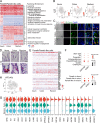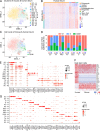Single-cell transcriptome analysis reveals differential nutrient absorption functions in human intestine
- PMID: 31753849
- PMCID: PMC7041720
- DOI: 10.1084/jem.20191130
Single-cell transcriptome analysis reveals differential nutrient absorption functions in human intestine
Abstract
The intestine plays an important role in nutrient digestion and absorption, microbe defense, and hormone secretion. Although major cell types have been identified in the mouse intestinal epithelium, cell type-specific markers and functional assignments are largely unavailable for human intestine. Here, our single-cell RNA-seq analyses of 14,537 epithelial cells from human ileum, colon, and rectum reveal different nutrient absorption preferences in the small and large intestine, suggest the existence of Paneth-like cells in the large intestine, and identify potential new marker genes for human transient-amplifying cells and goblet cells. We have validated some of these insights by quantitative PCR, immunofluorescence, and functional analyses. Furthermore, we show both common and differential features of the cellular landscapes between the human and mouse ilea. Therefore, our data provide the basis for detailed characterization of human intestine cell constitution and functions, which would be helpful for a better understanding of human intestine disorders, such as inflammatory bowel disease and intestinal tumorigenesis.
© 2019 Wang et al.
Figures












Comment in
-
Atlas of the human intestine.J Exp Med. 2020 Feb 3;217(2):e20191997. doi: 10.1084/jem.20191997. J Exp Med. 2020. PMID: 31922531 Free PMC article.
References
-
- Buettner F., Natarajan K.N., Casale F.P., Proserpio V., Scialdone A., Theis F.J., Teichmann S.A., Marioni J.C., and Stegle O.. 2015. Computational analysis of cell-to-cell heterogeneity in single-cell RNA-sequencing data reveals hidden subpopulations of cells. Nat. Biotechnol. 33:155–160. 10.1038/nbt.3102 - DOI - PubMed
Publication types
MeSH terms
Substances
LinkOut - more resources
Full Text Sources
Other Literature Sources
Molecular Biology Databases

